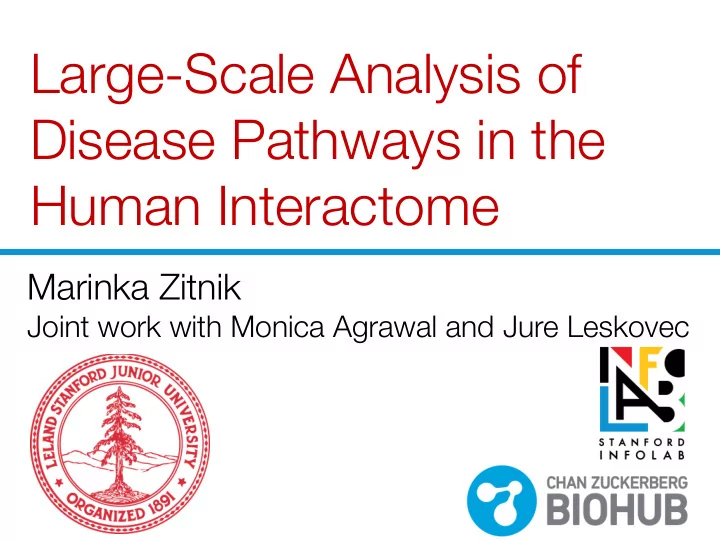

Large-Scale Analysis of Disease Pathways in the Human Interactome Marinka Zitnik Joint work with Monica Agrawal and Jure Leskovec
Human Interactome RAD50 RFC1 BRCA2 MSH4 PCNA FEN1 MED6 MSH5 DMC1 RAD51 Marinka Zitnik - Stanford University - http://snap.stanford.edu/pathways 2
Human Interactome RAD50 RFC1 BRCA2 MSH4 Network biology: PCNA Interacting proteins tend to lead FEN1 MED6 to similar phenotypes MSH5 DMC1 RAD51 [Menche et al., Science 2015, Costanzo et al., Science 2016] Marinka Zitnik - Stanford University - http://snap.stanford.edu/pathways 3
Disease Pathways § Pathway: Subnetwork of interacting proteins associated with a disease RAD50 RFC1 BRCA2 MSH4 PCNA Lung carcinoma FEN1 MED6 pathway MSH5 DMC1 RAD51 Marinka Zitnik - Stanford University - http://snap.stanford.edu/pathways 4
This Work: Research Question What is the protein interaction network structure of disease pathways? Marinka Zitnik - Stanford University - http://snap.stanford.edu/pathways 5
Disease Pathway Dataset Protein-protein interaction (PPI) network culled from § 15 knowledge databases: 350k physical interactions, e.g., metabolic enzyme-coupled § interactions, signaling interactions, protein complexes All protein-coding human genes (21k) § Protein-disease associations: § 21k associations split among 519 Mendelian and complex § diseases Disease categories, e.g., cancers (68), nervous § system diseases (44), cardiovascular diseases (33), immune system diseases (21) Pros: Experimentally validated data, comprehensive § analysis Marinka Zitnik - Stanford University - http://snap.stanford.edu/pathways 6
Prediction Task Marinka Zitnik - Stanford University - http://snap.stanford.edu/pathways 7
Methods and Setup § 5 methods: neural embeddings, matrix completion, neighbor scoring, diffusion, connectivity significance § Get a score for each node: probability that protein is associated with a disease § For each disease: § Train the method using training proteins § Predict disease proteins in test test Marinka Zitnik - Stanford University - http://snap.stanford.edu/pathways 8
Prediction Results § Best performers: hits@100 § Random walks hits@100 = 0.36 § Neural embeddings hits@100 hits@100 = 0.30 § Worst performer: § Neighbor scoring hits@100 hits@100 = 0.24 Full results for all methods in the paper. Marinka Zitnik - Stanford University - http://snap.stanford.edu/pathways 9
Prediction Results § Best performers: hits@100 § Random walks hits@100 = 0.36 Limited success of current methods § Neural embeddings Failure cases not well understood hits@100 hits@100 = 0.30 § Worst performer: § Neighbor scoring hits@100 hits@100 = 0.24 Full results for all methods in the paper. Marinka Zitnik - Stanford University - http://snap.stanford.edu/pathways 10
How can we explain failure cases of disease pathway prediction ? What is the network structure of disease pathways? Marinka Zitnik - Stanford University - http://snap.stanford.edu/pathways 11
Competing Views 1. Current: Traditional network clusters § Well connected internally § Localized in the PPI net § Few edges pointing outside 2. Our work: Multi-regional objects § Loosely interlinked § Distributed in the PPI net § Many edges pointing outside § Higher-order connectivity Marinka Zitnik - Stanford University - http://snap.stanford.edu/pathways 12
Are Pathways Well Interlinked? vs. Modularity ≈ 1 Modularity ≈ 0 Marinka Zitnik - Stanford University - http://snap.stanford.edu/pathways 13
Are Pathways Well Interlinked? vs. Modularity ≈ 1 Modularity ≈ 0 § No! - Pathways are embedded within PPI net § Modularity: Interactions within the pathway minus the expected interactions Marinka Zitnik - Stanford University - http://snap.stanford.edu/pathways 14
Are Pathways Connected? vs. Pathway components = 1 Pathway components = 4 Marinka Zitnik - Stanford University - http://snap.stanford.edu/pathways 15
Are Pathways Connected? vs. Pathway components = 1 Pathway components = 4 No! - Pathways have fragmented PPI structure: § 16 pathway components § 10% of pathways have 60+% proteins in the largest component Marinka Zitnik - Stanford University - http://snap.stanford.edu/pathways 16
Do Pathways Localize in Net? vs. Dispersed pathway Localized pathway Marinka Zitnik - Stanford University - http://snap.stanford.edu/pathways 17
Do Pathways Localize in Net? vs. Dispersed pathway Localized pathway Marinka Zitnik - Stanford University - http://snap.stanford.edu/pathways 18
Do Pathways Localize in Net? Disease pathways are weakly embedded in the PPI network, e.g.: Marinka Zitnik - Stanford University - http://snap.stanford.edu/pathways 19
Pathways are Multi-Regional! Marinka Zitnik - Stanford University - http://snap.stanford.edu/pathways 20
How To Proceed? § Network motifs: Higher-order network structures Marinka Zitnik - Stanford University - http://snap.stanford.edu/pathways 21
How To Proceed? § Network motifs: Higher-order network structures Do disease pathways utilize higher-order network structure? Marinka Zitnik - Stanford University - http://snap.stanford.edu/pathways 22
Counting Network Structures § 73 possible structures of size 2 to 5 nodes (edge à size-5 clique) Marinka Zitnik - Stanford University - http://snap.stanford.edu/pathways 23
Are Network Motifs Abundant? Marinka Zitnik - Stanford University - http://snap.stanford.edu/pathways 24
Are Network Motifs Abundant? Cardiovascular diseases , e.g., Cardiomyopathy, Tachycardia Cancers , e.g., Tumor of salivary gland, Thyroid carcinoma Marinka Zitnik - Stanford University - http://snap.stanford.edu/pathways 25
Are Network Motifs Abundant? § Higher-order structures provide additional signal past edge connectivity § Lead to better performance (11%, avg.) § Example: Hearing loss: hits@100 = 0.03 à à hits@100 = 0.77 Cardiovascular diseases , e.g., Cardiomyopathy, Tachycardia Cancers , e.g., Tumor of salivary gland, Thyroid carcinoma Marinka Zitnik - Stanford University - http://snap.stanford.edu/pathways 26
Summary & Conclusions § Current method assumptions not valid § Propose new prediction paradigm: § Disease pathways are loosely interlinked § Multi-regional objects with regions distributed throughout the PPI network § Higher-order connectivity is important snap.stanford.edu/pathways Marinka Zitnik - Stanford University - http://snap.stanford.edu/pathways 27
Recommend
More recommend